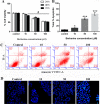Induction of Apoptosis by Berberine in Hepatocellular Carcinoma HepG2 Cells via Downregulation of NF-κB
- PMID: 28277195
- PMCID: PMC7840840
- DOI: 10.3727/096504016X14742891049073
Induction of Apoptosis by Berberine in Hepatocellular Carcinoma HepG2 Cells via Downregulation of NF-κB
Abstract
Hepatocellular carcinoma (HCC) is highly resistant to traditional chemotherapeutic approaches, which causes difficulty in the development of effective drugs for the treatment of HCC. Berberine, a major ingredient of Rhizoma coptidis, is a natural alkaloid used in traditional Chinese medicine. Berberine exhibits potent antitumor activity against HCC due to its high efficiency and low toxicity. In the present study, we found that berberine sensitized HepG cells to NF-κB-mediated apoptosis. Berberine exhibited a significant antiproliferation effect on the HepG2 cells and promoted apoptosis. Both qRT-PCR and immunofluorescence staining revealed that berberine reduced the NF-κB p65 levels in HepG2 cells. Moreover, p65 overexpression rescued berberine-induced cell proliferation and prevented HepG2 cells from undergoing apoptosis. These results suggest that berberine inhibits the growth of HepG2 cells by promoting apoptosis through the NF-κB p65 pathway.
Conflict of interest statement
The authors declare no conflicts of interest.
Figures





References
-
- Lim SC, Choi JE, Kang HS, Han SI. Ursodeoxycholic acid switches oxaliplatin-induced necrosis to apoptosis by inhibiting reactive oxygen species production and activating p53-caspase 8 pathway in HepG2 hepatocellular carcinoma. Int J Cancer 2010;126(7):1582–95. - PubMed
-
- Jeong HW, Hsu KC, Lee JW, Ham M, Huh JY, Shin HJ, Kim WS, Kim JB. Berberine suppresses proinflammatory responses through AMPK activation in macrophages. Am J Physiol Endocrinol Metab. 2009;296(4):E955–64. - PubMed
-
- Pirillo A, Catapano AL. Berberine, a plant alkaloid with lipid- and glucose-lowering properties: From in vitro evidence to clinical studies. Atherosclerosis 2015;243(2):449–61. - PubMed
-
- Patil JB, Kim J, Jayaprakasha GK. Berberine induces apoptosis in breast cancer cells (MCF-7) through mitochondrial-dependent pathway. Eur J Pharmacol. 2010;645(1–3):70–8. - PubMed
MeSH terms
Substances
LinkOut - more resources
Full Text Sources
Other Literature Sources
Medical
Research Materials
